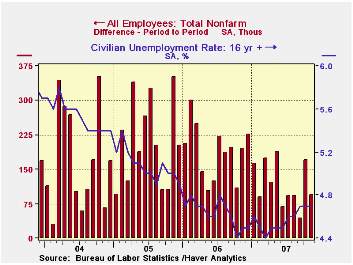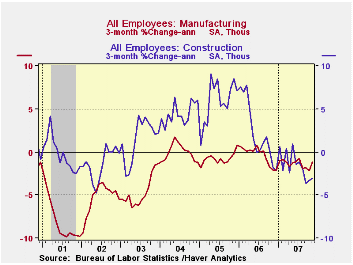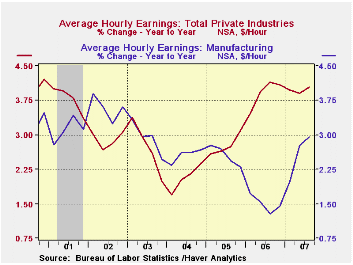 Global| Dec 07 2007
Global| Dec 07 2007U.S. Payrolls Increase Light, Unemployment Steady
by:Tom Moeller
|in:Economy in Brief
Summary
The 94,000 worker rise in nonfarm payrolls in November reported today by the Bureau of Labor Statistics was a bit stronger than early expectations for a 70,000 increase. However, it was much weaker than forecasts which were ratcheted [...]

The 94,000 worker rise in nonfarm payrolls in November reported today by the Bureau of Labor Statistics was a bit stronger than early expectations for a 70,000 increase. However, it was much weaker than forecasts which were ratcheted up after Wednesday's ADP report of a strong gain in private nonfarm payrolls. And while the increase was accompanied by a slight upward revision to the gain in October jobs, the rise in September employment was more than halved to 44,000.
The unemployment rate held steady at 4.7% last month. Household employment surged 696,000 (0.7% y/y) and more than offset the prior month's 250,000 decline. The labor force also surged 617,000 (0.9% y/y). The labor force participation rate jumped to 66.1%, its highest level since July but still down from 66.2% averaged last year.
The level of average hours worked has remained notably stable recently. As a result, for the fourth quarter so far the level of aggregate hours worked (employment times hours) is up just 0.9% (AR) following a 3Q rise of 1.2%. During the last ten years there has been a 44% correlation between the gain in hours and the gain in real GDP. That correlation is down from 56% over the last 20 years and from 74% over the last 30 due to the faster growth in worker productivity.
Private service sector jobs increased 97,000 (1.7% y/y) last month after an unrevised gain of 154,000 in October. Retail employment grew 24,200 (0.4% y/y) and professional & business service jobs rose 30,000 (1.8% y/y). Jobs in the education sector ticked up 2,000 (2.6% y/y) while the health care sector added 25,300 workers (3.2% y/y). Employment in the temporary help industry rose by 11,300 (-1.2% y/y).
Job losses in the service sector were logged in the finance industry. The 20,000 worker decline (-0.1% y/y) was the fifth decline in the last six months. In addition, following the drop off in the housing industry, real estate employment fell 10,800 (-0.2% y/y) for the second decline in the last three months.
Employment in the government sector also rose a modest 30,000 (1.1% y/y) after a 38,000 worker increase in October. Very weak hiring by the Federal government (-0.3% y/y) has held back gains in the total.
Factory sector payrolls fell further by11,000, adding to a decline that began early last year. These declines remain at odds with the ISM reports of job growth in manufacturing. Construction employment fell 24,00 last month.
Average hourly earnings increased 0.3% while the prior month's gain was revised down sharply and now shows a decline of 0.2%. Factory sector earnings bounced back 0.4% (2.7% y/y) from a 0.3% decline in October which was initially reported as an increase. Private service-providing earnings rose 0.3% (3.9% y/y) following a 0.2% October decline that also was originally reported as an increase.
The minimum wage and the labor market from the Federal Reserve Bank of Cleveland can be found here.
Fed GovernorRandall S. Kroszner's speech titled Loan Modifications and Foreclosure Prevention is available here.
| Employment : 000s | November | October | September | Y/Y | 2006 | 2005 | 2004 |
|---|---|---|---|---|---|---|---|
| Payroll Employment | 94 | 170 | 44 | 1.2% | 1.9% | 1.7% | 1.1% |
| Previous | -- | 166 | 96 | -- | -- | -- | -- |
| Manufacturing | -11 | -15 | -15 | -1.3% | -0.2% | -0.6% | -1.3% |
| Construction | -24 | -9 | -25 | -1.6% | 4.8% | 5.2% | 3.6% |
| Average Weekly Hours | 33.8 | 33.8 | 33.8 | 33.8 (Nov '06) | 33.8 | 33.8 | 33.7 |
| Average Hourly Earnings | 0.3% | -0.2% | 1.3% | 3.8% | 3.9% | 2.8% | 2.1% |
| Unemployment Rate | 4.7% | 4.7% | 4.7% | 4.5% (Nov '06) | 4.6% | 5.1% | 5.5% |
Tom Moeller
AuthorMore in Author Profile »Prior to joining Haver Analytics in 2000, Mr. Moeller worked as the Economist at Chancellor Capital Management from 1985 to 1999. There, he developed comprehensive economic forecasts and interpreted economic data for equity and fixed income portfolio managers. Also at Chancellor, Mr. Moeller worked as an equity analyst and was responsible for researching and rating companies in the economically sensitive automobile and housing industries for investment in Chancellor’s equity portfolio. Prior to joining Chancellor, Mr. Moeller was an Economist at Citibank from 1979 to 1984. He also analyzed pricing behavior in the metals industry for the Council on Wage and Price Stability in Washington, D.C. In 1999, Mr. Moeller received the award for most accurate forecast from the Forecasters' Club of New York. From 1990 to 1992 he was President of the New York Association for Business Economists. Mr. Moeller earned an M.B.A. in Finance from Fordham University, where he graduated in 1987. He holds a Bachelor of Arts in Economics from George Washington University.






